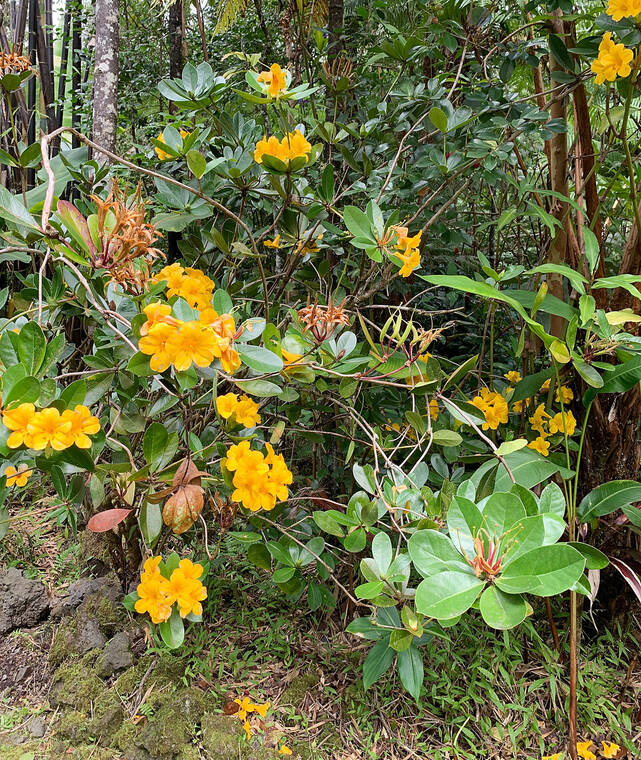The weather is a bit crazy now. Temperatures remain warm but things are about to change. Fall has officially arrived in the northern hemisphere since the sun has moved south of the equator. The autumnal equinox for us is spring for those south of the equator. As the sun moves further from us, days are shorter and plants tend to slow their growth.
Living in Hawaii, even though we don’t see the brilliant fall colors ablaze in the forests and gardens of the mainland, we can improvise. So now is the time for nursery and garden store shopping. You can find some great ideas for bringing the feeling of fall into our gardens. Where nights are cool and days frequently cloudy, try some of the fancy new impatiens hybrids. The New Guinea hybrids are especially attractive. These new hybrids are much more compact and flower abundantly. They come in all flower colors and have multicolored leaves as well. Other impatiens on the market are the traditional types hybridized to be compact and floriferous.
The vireya rhododendrons are starting off the fall with appropriate color blooms of orange and yellows. A great opportunity to obtain some unique varieties is happening this weekend. According to Sherla Bertelmann, the Rhododendron Society is having its October meeting at the Pana’ewa Rainforest Zoo and Garden at 10 a.m. Sunday. The theme is “Talk Vireya Story,” so there will be folks there to help you with propagation, cultivation and procuring some plants to embellish your garden. Plan on bringing a sack lunch. Refreshments will be provided.
Fall in Hawaii is colorful with African Tulip, Timor Shower, Rainbow Shower and even the Royal Poinciana trees in late bloom. Also flowering now are several species of Bauhinia or Orchid trees. One seldom seen here but common in cooler regions of South America is the Silk Floss Tree or Ceiba speciosa. This close relative of the Kapok tree is rare here but popular in Southern California. Some Hawaii nurseries will bring it in on request from California nurseries. Your garden could be even brighter with the addition of crotons, bougainvillea and hibiscus just to mention a few.
Besides the many tropical ornamentals trees and shrubs available, you might also consider colorful annuals and perennials to brighten your winter garden or lanai. Many of the annual summer flowers that are prized most on the mainland are at their best here from November to May. These annuals are usually tolerant of cool weather. Since the winter temperature never goes extremely low, they thrive here, especially at higher elevations like Waimea and Volcano.
Some, like the marigold are great the year-round. They are especially good for sunny drier locations. The marigold is native to the Southwestern United States and to Mexico. It grows well and is popular in every state, from Florida to Maine and from Hawaii to Alaska.
When Cortez conquered ancient Mexico, he found marigolds growing there. The gorgeous golden Marigolds were so beautiful that Cortez took seeds with him back to Spain. There, marigolds became the favorite flower of the devout to place at the altar of the Virgin Mary and because of that, they were called Mary’s gold and then became known as marigolds. They were so easy to grow and so beautiful, they grew popular everywhere. In India, marigolds are, the favorite flower for leis to place around a person’s neck to indicate friendship, and because of that, they have become known as friendship flowers.
Many different types of marigolds, from big flowered American and smaller flowered, so called “French”, odor and odorless, are available at your local garden supply store.
Marigolds, zinnias, petunias, and many other annuals with bright blooms are natural for adding color. You may also expand the beauty and interest of your floral borders by including low maintenance foliage plants. What are some of the best to add color and texture contrast? Coleus immediately comes to mind and is probably the most popular. Little wonder, it’s so versatile and vivid! The plants with their brilliantly patterned leaves are flashy in sun or shade. You’ll especially appreciate how coleus can transform problem shady spots into rainbow of color. Use it to beautify areas along the north or east sides of your house or garage or in containers on shady porches or patios, even under trees. Coleus can also take direct sun in cooler gardens. Coleus is just as much a favorite houseplant as it is a garden subject. They thrive in pots and are easy to propagate by cuttings.
Other favorites include the many varieties of Begonia, Canna, Caladium andGeranium.
Using your creativity, you can brighten your home and garden from fall until spring.



